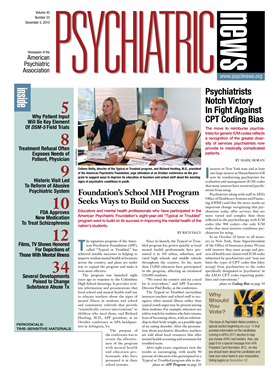In October, the U.S. Food and Drug Administration (FDA) approved another second-generation antipsychotic (SGA), Latuda (lurasidone), for the treatment of schizophrenia in adults. The newly approved medication by Sunovion Pharmaceuticals Inc. is the manufacturer's first to gain FDA approval. The company, which is the U.S. subsidiary of Dainippon Sumitomo Pharma Co. Ltd., was formed by a merger with Sepracor Inc. in April.
Jeffrey Lieberman, M.D., chair of APA's Council on Research and Quality Care and professor and chair of the Department of Psychiatry at Columbia University's College of Physicians and Surgeons, commented on the new drug to Psychiatric News.
“The most notable distinction between it and other atypical agents of the same class,” he said, “is its high affinity for the 5-HT7 receptor and its preclinical evidence for cognitive enhancement, but this has to be confirmed by future studies.” (The drug's binding affinity for the serotonin type 7 [5-HT7] receptor in the brain is one way that this new medication is thought to elicit effects in treating symptoms of schizophrenia.)
This same evidence, he continued, “may also contribute to fewer extrapyramidal symptoms [EPS] based on the drug's potent in vitro binding affinity for D2 receptors.”
With regard to EPS, lurasidone's profile is “similar to that of risperidone, olanzapine, and ziprasidone but is worse than clozapine and quetiapine,” said Lieberman.
Lieberman pointed out that lurasidone was “reviewed by the FDA in record time. This may be due to either the efficiency in the development process by the drug company or improved efficiency of reviews of new drugs by the FDA under the leadership of Hamburg.” Margaret Hamburg, M.D., was appointed FDA commissioner in 2009.
According to the manufacturer, lurasidone is expected to be available in pharmacies beginning in February 2011.
Lurasidone's exact mechanism of action is unknown. According to the manufacturer, the effects of lurasidone are thought to be mediated in part by antagonism at central dopamine type 2 (D2) and serotonin type 2A (5-HT2A) receptors. Lurasidone also has the ability to antagonize α1 receptors, which may result in orthostatic hypotension and/or syncope.
Like other SGAs, the medication's prescribing information carries a blackbox warning. The warning describes the increased risk of death associated with the off-label prescribing of SGAs, especially when these agents are used to treat behavioral problems in the elderly suffering from dementia-related psychosis.
The FDA approval of lurasidone is based on data collected from 40 clinical trials, including four six-week controlled clinical trials that examined the safety and efficacy of lurasidone in adults with schizophrenia. Treatment with lurasidone was associated with improvements in both positive and negative symptoms, including delusions, hallucinations, flat affect, memory, and attention.
Researchers reported that patients treated with lurasidone showed not only improvements in symptoms, but also decreases in the severity or worsening of EPS. These improvements were indicated by patients' Positive and Negative Syndrome Scale scores, as well as scores on the Brief Psychiatric Rating Scale.
The most commonly reported side effects in the clinical trials were agitation, akathisia, nausea, Parkinsonian-like symptoms, and somnolence. Adverse effects such as akathisia and somnolence appeared to be dose related. Even at lower doses, side effects such as dizziness and postural hypotension were also reported. However, “the side-effect profile is favorable for a low risk of weight gain and metabolic side effects,” Lieberman said.
According to the prescribing information, lurasidone is contraindicated in patients who are also taking medications that are strong CYP3A4 inhibitors or inducers such as ketoconazole or rifampin, respectively. Additionally, it is recommended that dosage adjustments be considered in patients who are also taking drugs that are moderate CYP3A4 inhibitors or have moderate to severe renal or hepatic impairment. In these instances, the dosage of the drug should not exceed 40 mg daily, according to the manufacturer.
Lurasidone is available in 40 mg and 80 mg tablets. The recommended starting dose is 40 mg, which may be increased to the recommended maximum daily dosage of 80 mg. Lurasidone should be taken by mouth, once daily, with food.
